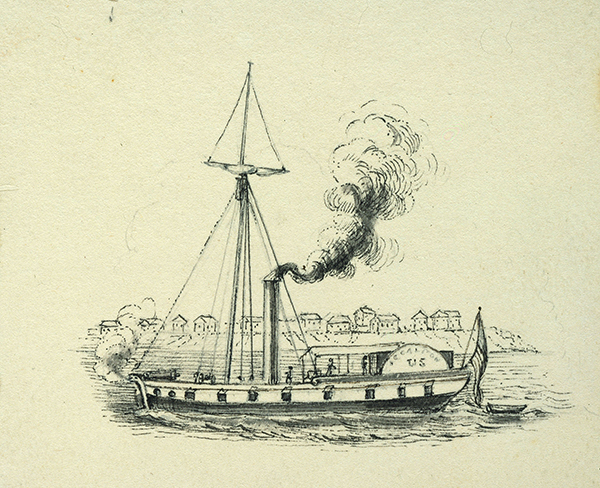
Venting steam from its nostrils, the serpent-headed white boat moved mysteriously up the Missouri River without sails or oarsmen.
The boat’s source of power may have been unknown to the people on shore, but some things about it were instantly recognizable: the stars and stripes of the US flag, and the artillery pieces on deck. Here was a warship unlike anything the people of the Missouri River had ever seen.
The year was 1819, the place was the future states of Nebraska and Iowa, and the boat was the Western Engineer, the first steamboat to travel this far up the Missouri. It transported a team of scientists to their winter camp north of present-day Omaha, a placed they named Engineer Cantonment (a “cantonment” is a long-term camp).
Steamboats were the latest technology in the early 19th century—nothing quaint or old-timey about them in those days. Built in Pittsburgh, Western Engineer was also one of the first sternwheelers, having a single paddlewheel at the back of the boat instead of two paddlewheels on either side. This was better for narrow channels in the often shallow Missouri. When empty, the boat could float in only 19 inches of water.
Western Engineer was special in other ways. It was designed to awe and frighten the native peoples with whom the US military sought to make treaties. That was the purpose of the steam-venting serpent’s head at the prow, and the deliberate effort to hide the boat’s machinery and display its weapons. Its designers wanted to create the illusion of a giant black serpent carrying a gunboat on its back.
Threating violence with one hand, with the other the US came offering peace and trade. They hoped to lure the tribes into exclusive fur trade agreements with the US and forsake the British traders operating out of Canada.
Native peoples apparently did find the strange boat disturbing, but they didn’t forget their own economic interests. British traders offered trade goods that were consistently superior to what the Americans offered, and there was an advantage to keeping one’s trade options open. In the end, Native leaders were a lot savvier than the US hoped they would be. The politics of the fur trade were far from over.
But the Missouri River steamboat era was just beginning.
— David Bristow, Editor



